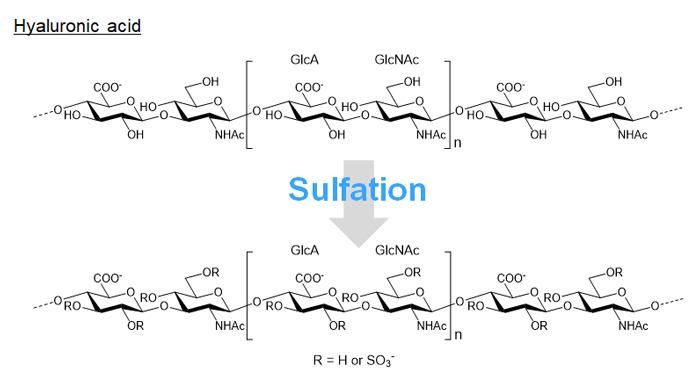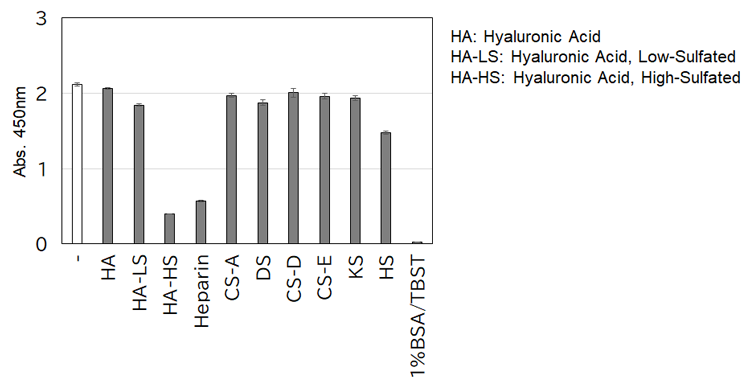Make sure to sign up for an account today for exclusive coupons and free shipping on orders over $75!
Maximum quantity allowed is 999
[Glycoscience TOPICS] A New Function of the Highly Sulfated Hyaluronic Acid
Potential for the development of protective drugs against radiation damage to the intestinal tract without inducing bleeding
The Institute of Glycotechnology of Tokyo Chemical Industry Co., Ltd. (TCI), Group Leader Fumiaki Nakayama and Dr. Taichi Miura of the Regenerative Therapy Research Group, Department of Radiation Regulatory Science Research, National Institute of Radiological Sciences (NIRS) have discovered a new function of the highly sulfated hyaluronic acid commercialized by TCI. It provides protection against intestinal damage and does not induce bleeding. Its expected application will be in the development of drugs that prevent damage caused by radiotherapy to the intestinal tract and other parts of the body.

Like heparin, hyaluronic acid is a polysaccharide classified as a glycosaminoglycan. Sulfated hyaluronic acid has already been reported to bind to fibroblast growth factor (FGF) 2 and others. Additionally, it has been used in maintaining the induced pluripotent stem (iPS) cells in an undifferentiated state. TCI has developed and commercialized a technology for the large-scale production of sulfated hyaluronic acid using a technology for the high-precision sulfation of hyaluronic acid. (highly sulfated hyaluronic acid; Product Number: H1739)

HA-LS showed weaker binding capability than heparin and HA-HS showed stronger binding capability than heparin.
Various radiotherapy protection methods have been investigated in previous studies, and FGF1 has been examined for its protective effect on the small intestine against radiation damage. Heparin is said to stabilizes the FGF1 structure, resulting in a highly protective effect. However, heparin inhibits blood coagulation and promotes bleeding, making it difficult to use in patients with radiological intestinal disorders at the risk of excess bleeding. Therefore, we need to develop a drug that can stabilize the structure of FGF1 without promoting bleeding.
The Regenerative Therapy Research Group studied the protective action of highly sulfated hyaluronic acid on the degradation of growth factors and evaluated its efficacy against radiological damage to the intestinal tract. The sulfated hyaluronic acid was as effective as the combination of FGF1 and heparin. Furthermore, highly sulfated hyaluronic acid had limited blood anticoagulant activity. These results indicate that highly sulfated hyaluronic acid is a promising radioprotective agent associated with a low risk of bleeding that prevents the induction of hemorrhage, which is an issue concerned with the combination of FGF1 and heparin.
The features of sulfated hyaluronic acid identified in this study are as follows:
- It has a protective effect against the radiation damage to the intestinal tract.
- It does not interfere with blood coagulation, in contrast to heparin.
- It is a promising radiation damage protective agent with a low risk of bleeding.
The research was published in the online edition of Advances in Radiation Oncology, a scientific journal published by the American Society for Radiation Oncology, on March 13, 2022.
TCI will continue to develop a joint research effect to broaden the application of this material in various fields. Additionally, we are open to consulting with developers on the degree of sulfation, molecular weight, and further modifications according to their requirements.
Term Description
- 1) Radiation intestinal damage
- Refers to symptoms caused by irradiation of the highly radiosensitive gastrointestinal tract, such as the small intestine. In some cases, the tumor may not be irradiated with a sufficient dose, necessitating the development of drugs to prevent collateral damage.
- 2) Fibroblast Growth Factor 1, (FGF1)
- FGF1 is a widely distributed cell growth factor expressed in a variety of tissues. It functions as an angiogenic and neurotrophic factor and is used in research applications such as cell culture.
- 3) Heparin
- Heparin is a polysaccharide composed of tens to hundreds of repetitions of a single unit of disaccharide composed of uronic acid and glucosamine. Heparan sulfates, particularly those that are highly sulfated, are also classified as heparin.
- 4) Culture of iPS cells to maintain their undifferentiated state
- The culture method required for industrial application of iPS cells necessitates culturing a large number of cells while maintaining their undifferentiated state. Simple iPS cell culture methods have yet to be developed.
Article information
Advances in Radiation Oncology
- Title:
- High-sulfated hyaluronic acid ameliorates radiation-induced intestinal damage without blood anticoagulation
- Author:
- Taichi Miura, Ph.D.,1 Mitsuko Kawano, Ph.D.,1 Keiko Takahashi, B.S.,1 Noriyuki Yuasa, Ph.D.,2 Masato Habu,2 Fumie Kimura, B.S.,2 Toru Imamura, Ph.D.,1,3 Fumiaki Nakayama, M.D., Ph.D.1
- Affiliations:
- 1. Regenerative Therapy Research Group, National Institutes for Quantum Science and Technology (QST), Chiba, Japan
2. Tokyo Chemical Industry Co., Ltd. (TCI), Tokyo, Japan
3. School of Bioscience and Biotechnology, Tokyo University of Technology, Hachioji, Japan - DOI:
- https://doi.org/10.1016/j.adro.2022.100900
References
- SUBSTRATE FOR CELL CULTURE AND CULTURE METHOD, PCT/JP2019/006806. Applicants SOKA UNIVERSITY, TOKYO CHEMICAL INDUSTRY CO., LTD.
- Highly sulfated hyaluronic acid maintains human induced pluripotent stem cells under feeder-free and bFGF-free conditions.
- Post Treatment With an FGF Chimeric Growth Factor Enhances Epithelial Cell Proliferation to Improve Recovery From Radiation-Induced Intestinal Damage.
- Structural Stability of Human Fibroblast Growth Factor-1 Is Essential for Protective Effects Against Radiation-Induced Intestinal
Related Information
- Glycoscience TOPICS: Sulfated Hyaluronic Acid
- Product Brochure: Sulfated Hyaluronic Acids (PDF file)
- Movie: Protective effects of sulfated hyaluronic acid on growth factors
- National Institutes for Quantum Science and Technology (QST) Press release (in Japanese)

